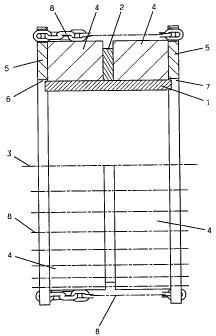Some of the information on this Web page has been provided by external sources. The Government of Canada is not responsible for the accuracy, reliability or currency of the information supplied by external sources. Users wishing to rely upon this information should consult directly with the source of the information. Content provided by external sources is not subject to official languages, privacy and accessibility requirements.
Any discrepancies in the text and image of the Claims and Abstract are due to differing posting times. Text of the Claims and Abstract are posted:
| (12) Patent: | (11) CA 2394601 |
|---|---|
| (54) English Title: | FEED ROLLER AND A METHOD FOR ASSEMBLING A FEED ROLLER |
| (54) French Title: | ROULEAU D'ENTRAINEMENT ET PROCEDE D'ASSEMBLAGE D'UN ROULEAU D'ENTRAINEMENT |
| Status: | Expired |
| (51) International Patent Classification (IPC): |
|
|---|---|
| (72) Inventors : |
|
| (73) Owners : |
|
| (71) Applicants : |
|
| (74) Agent: | SMART & BIGGAR IP AGENCY CO. |
| (74) Associate agent: | |
| (45) Issued: | 2008-07-08 |
| (86) PCT Filing Date: | 2000-12-08 |
| (87) Open to Public Inspection: | 2001-07-05 |
| Examination requested: | 2003-11-06 |
| Availability of licence: | N/A |
| (25) Language of filing: | English |
| Patent Cooperation Treaty (PCT): | Yes |
|---|---|
| (86) PCT Filing Number: | PCT/SE2000/002471 |
| (87) International Publication Number: | WO2001/047672 |
| (85) National Entry: | 2002-06-17 |
| (30) Application Priority Data: | ||||||
|---|---|---|---|---|---|---|
|
Feed roller in tree processing machinery for feeding
tree trunks through the machinery distinguished in that the
flange (2) is arranged essentially in the centre of the wheel rim
(1) and that a track (4) of elastic material is arranged on either
side of the flange (2). A ring (5) is arranged on the side of the
respective track (4) that is opposite the flange, whereby the rings
(5) that abut the outer sides of the elastic track on either side of the
wheel are joined with one another by means of tensioning devices
(8).
L'invention se rapporte à un rouleau d'entraînement mis en oeuvre dans une machine de traitement du bois et conçu pour amener des troncs d'arbres dans ladite machine. Ce rouleau d'entraînement se caractérise en ce qu'il comporte une bride (2) disposée sensiblement au centre de la jante (1) de roue et en ce qu'un tracé (4) de matière élastique est disposé de part et d'autre de la bride (2). Un anneau (5) est disposé sur le côté du tracé respectif (4) qui est opposé à la bride, ce qui permet aux anneaux (5) qui sont en aboutement avec les côtés externes du tracé élastique de part et d'autre de la roue de s'assembler au moyen de dispositifs de mise en tension (8).
Note: Claims are shown in the official language in which they were submitted.
Note: Descriptions are shown in the official language in which they were submitted.

For a clearer understanding of the status of the application/patent presented on this page, the site Disclaimer , as well as the definitions for Patent , Administrative Status , Maintenance Fee and Payment History should be consulted.
| Title | Date |
|---|---|
| Forecasted Issue Date | 2008-07-08 |
| (86) PCT Filing Date | 2000-12-08 |
| (87) PCT Publication Date | 2001-07-05 |
| (85) National Entry | 2002-06-17 |
| Examination Requested | 2003-11-06 |
| (45) Issued | 2008-07-08 |
| Expired | 2020-12-08 |
There is no abandonment history.
| Fee Type | Anniversary Year | Due Date | Amount Paid | Paid Date |
|---|---|---|---|---|
| Application Fee | $300.00 | 2002-06-17 | ||
| Maintenance Fee - Application - New Act | 2 | 2002-12-09 | $100.00 | 2002-06-17 |
| Registration of a document - section 124 | $100.00 | 2002-10-01 | ||
| Request for Examination | $400.00 | 2003-11-06 | ||
| Maintenance Fee - Application - New Act | 3 | 2003-12-08 | $100.00 | 2003-11-19 |
| Maintenance Fee - Application - New Act | 4 | 2004-12-08 | $100.00 | 2004-11-10 |
| Maintenance Fee - Application - New Act | 5 | 2005-12-08 | $200.00 | 2005-11-15 |
| Maintenance Fee - Application - New Act | 6 | 2006-12-08 | $200.00 | 2006-11-14 |
| Maintenance Fee - Application - New Act | 7 | 2007-12-10 | $200.00 | 2007-11-28 |
| Final Fee | $300.00 | 2008-04-24 | ||
| Maintenance Fee - Patent - New Act | 8 | 2008-12-08 | $200.00 | 2008-11-24 |
| Maintenance Fee - Patent - New Act | 9 | 2009-12-08 | $200.00 | 2009-11-09 |
| Maintenance Fee - Patent - New Act | 10 | 2010-12-08 | $250.00 | 2010-11-08 |
| Maintenance Fee - Patent - New Act | 11 | 2011-12-08 | $250.00 | 2011-11-23 |
| Maintenance Fee - Patent - New Act | 12 | 2012-12-10 | $250.00 | 2012-11-30 |
| Maintenance Fee - Patent - New Act | 13 | 2013-12-09 | $250.00 | 2013-11-18 |
| Maintenance Fee - Patent - New Act | 14 | 2014-12-08 | $250.00 | 2014-11-26 |
| Maintenance Fee - Patent - New Act | 15 | 2015-12-08 | $450.00 | 2015-11-16 |
| Maintenance Fee - Patent - New Act | 16 | 2016-12-08 | $450.00 | 2016-11-14 |
| Maintenance Fee - Patent - New Act | 17 | 2017-12-08 | $450.00 | 2017-11-14 |
| Maintenance Fee - Patent - New Act | 18 | 2018-12-10 | $450.00 | 2018-11-22 |
| Maintenance Fee - Patent - New Act | 19 | 2019-12-09 | $450.00 | 2019-11-20 |
Note: Records showing the ownership history in alphabetical order.
| Current Owners on Record |
|---|
| PARTEK FOREST AB |
| Past Owners on Record |
|---|
| NILSSON, GUNNAR |